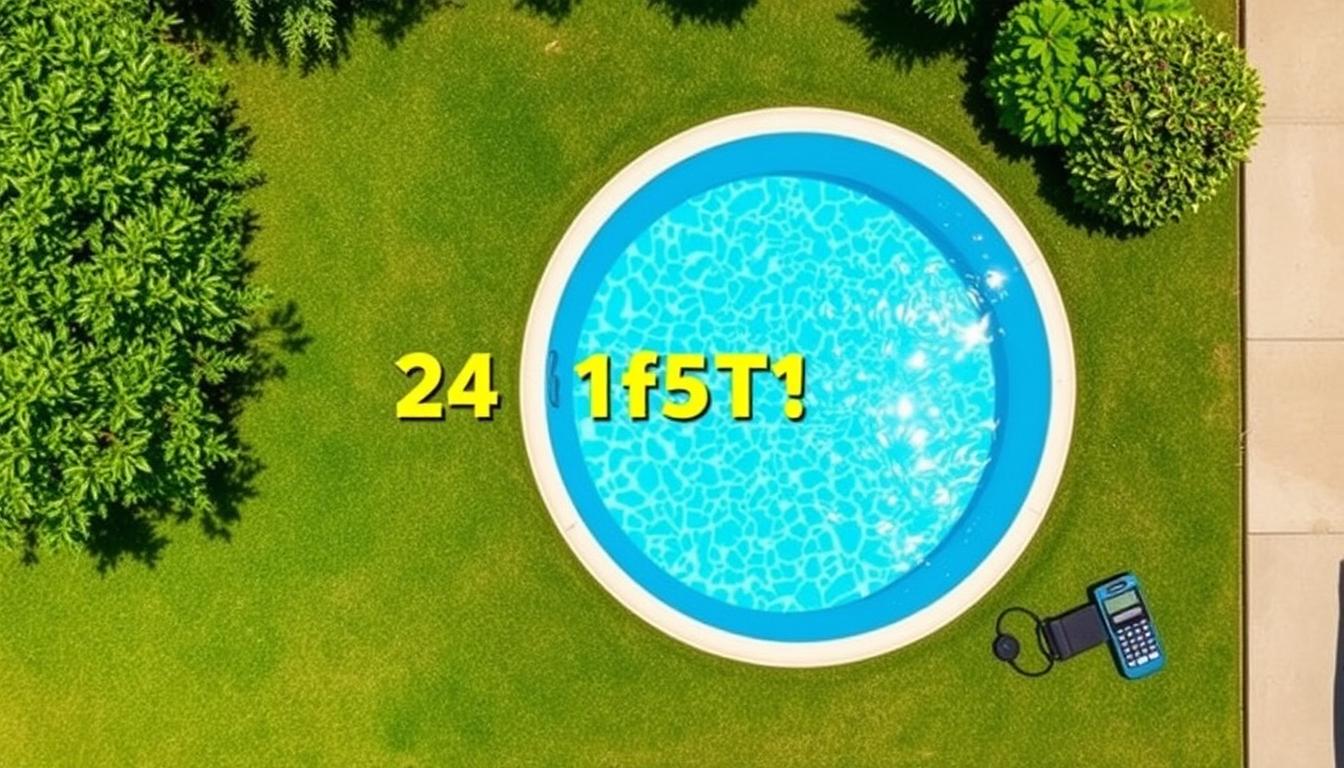
A 24 foot round pool can hold about 14,000 gallons of water. That’s enough to fill over 1,800 standard bathtubs! Understanding your pool’s capacity is crucial for proper maintenance.
Pool capacity calculation might seem tricky at first. But with the right tools and knowledge, it becomes easy. The pool’s diameter and average depth are key factors.
Knowing your pool’s volume helps keep it in great shape. It’s essential for maintaining water balance and adding the right amount of chemicals.
This knowledge is vital for both new and experienced pool owners. It ensures a safe and fun swimming experience for everyone.
Key Takeaways
- A 24 foot round pool typically holds around 14,000 gallons of water
- Accurate pool capacity calculation is essential for maintaining proper water balance and chemical dosing
- Pool volume estimation relies on swimming pool dimensions such as diameter and average depth
- Circular pool sizing and residential pool measurements are key factors in determining gallon capacity
- Mastering pool volume calculation ensures a safe and enjoyable swimming experience for all
Understanding Pool Volume Calculations
Knowing your pool’s water volume is crucial. It helps determine chemical dosages and water balance. It also aids in estimating filling or refilling costs.
Accurate pool volume estimation is essential for proper maintenance. Let’s explore the factors that affect pool capacity.
Factors Affecting Pool Capacity
Several key elements influence your pool’s water volume. These include pool shape, dimensions, and average depth.
- Pool shape: The shape affects capacity. Each shape requires a specific formula for accurate volume calculation.
- Pool dimensions: Length, width, and depth directly impact water volume. Larger pools hold more water than smaller ones.
- Average depth: Calculate this by measuring the shallowest and deepest points. Divide the sum by two.
The table below shows how pool dimensions affect water capacity:
| Pool Type | Dimensions | Average Depth | Volume (US Gallons) |
|---|---|---|---|
| Rectangular | 12′ x 24′ | 4′ | 8,640 |
| Rectangular | 16′ x 32′ | 5′ | 19,200 |
| Circular | 24′ diameter | 4′ | 13,593 |
| Oval | 15′ x 30′ | 4′ | 10,620 |
Importance of Accurate Pool Volume Estimation
Precise pool volume estimation is crucial for several reasons:
- Chemical balance: Exact volume allows proper chemical addition. This prevents water quality issues and health hazards.
- Cost management: Knowing capacity helps estimate filling costs. This aids in budgeting for pool maintenance.
- Equipment sizing: Accurate estimation ensures selecting the right pool equipment. This optimizes performance and energy efficiency.
“Proper pool maintenance begins with understanding your pool’s unique characteristics, including its shape, size, and water volume. By accurately calculating your pool’s capacity, you can take the first step towards creating a safe and enjoyable swimming environment for your family and friends.”
Next, we’ll guide you through calculating gallons in a 24-foot round pool. This knowledge will help you maintain your backyard oasis effectively.
Calculating Gallons in a 24 Foot Round Pool
Accurate pool volume estimates are crucial for proper maintenance and filling. Knowing your pool’s gallon capacity helps plan for costs and chemical balance. Let’s explore how to calculate the volume of a 24-foot round pool.
Formula for Determining Pool Volume
The formula for a circular pool’s gallon capacity is: Diameter x Diameter x Average Depth x 5.9. This calculation considers the pool’s diameter and average depth. The multiplier 5.9 is specific to circular pools.
Step-by-Step Guide to Calculating Gallons in a 24 Foot Round Pool
Follow these steps to estimate your pool’s water volume:
1. Measure the pool’s diameter in feet. In this case, it’s 24 feet.
2. Calculate the average depth by measuring shallow and deep ends, then dividing by 2.
3. Square the diameter by multiplying it by itself. For a 24-foot pool, it’s 24 x 24 = 576.
4. Multiply the squared diameter by the average depth.
5. Multiply the result by 5.9 to get the pool gallon capacity.
Common Mistakes to Avoid When Estimating Pool Capacity
Avoid mistakes like using incorrect measurements or forgetting to calculate average depth. Always double-check your measurements and calculations. Use the right formula for your pool’s shape to ensure accuracy.
By taking these precautions, you’ll get a reliable estimate of your pool’s capacity. This will help you plan for filling, maintenance, and chemical treatment.







